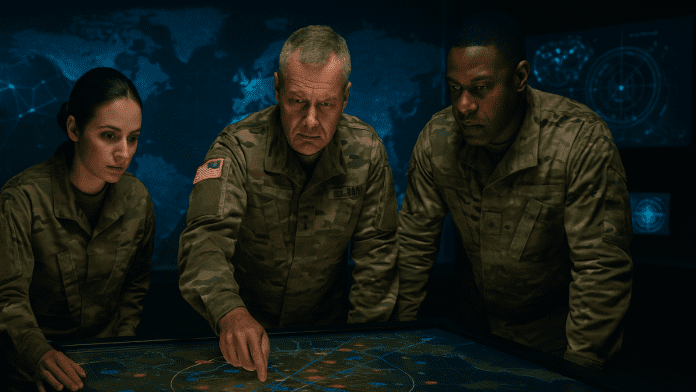The U.S. Department of Defense has started using artificial intelligence (AI) in a brand-new way to improve military training. The Department of Defense launched a project called Thunderforge, which uses AI agents to simulate battles and test military strategies.
US Department of Defense Launches Thunderforge Project Using AI
These AI agents don’t represent real people. Developers created these smart software programs to act like soldiers, commanders, or even enemy forces in a computer simulation. The purpose of these agents is to help the military create and test battle plans in a safe and controlled digital environment.
According to a report in IEEE Spectrum, the Thunderforge project is developing autonomous AI agents that can make their own decisions. That means they don’t just follow instructions—they react to situations as they unfold, just like a real person would. For example, if an enemy makes a sudden move, the AI agent acting as a soldier can quickly change its tactics without waiting for instructions.
Pentagon confirms Iranian missile hit key US base in Qatar — geodesic dome destroyed
Experts call this type of simulation a military wargame, where planners use high-tech systems to test and develop strategies before actual combat. With the help of AI, these wargames are becoming more complex and realistic, giving the military better tools to prepare for different types of threats.
How AI Agents Help in Creating Complex Battle Scenarios
One of the most important parts of the Thunderforge project is the ability of AI agents to create many different battle situations. Instead of relying on humans to manually design each scenario, these agents can generate thousands of unique and detailed simulations. This includes everything from small surprise attacks to full-scale battles across land, sea, and air.
Because AI agents can make decisions on their own, they allow simulations to evolve naturally. For instance, if one side wins an early battle, the AI might change its strategy in later stages. This makes the training more realistic and helps soldiers and commanders prepare for situations that could happen in real life.
These agents are also not limited to one side. They can represent both friendly and enemy forces. That way, the military can test how different strategies work against smart and unpredictable opponents—something that’s hard to do with traditional simulations.
Watchdog Raises Alarm as Tech Chiefs with DoD Ties Join Army
The goal is to create a diverse and challenging environment where tactics can be tested under pressure. It also helps identify weaknesses in existing strategies. AI makes it easier to repeat tests and change variables like terrain, weather, or enemy strength, without needing large teams of human planners.
The Thunderforge project is still under development, but it represents a major step forward in how the military uses technology to stay prepared. By combining smart software with detailed wargame systems, the Department of Defense hopes to make military training faster, more efficient, and more flexible.
Why Thunderforge Matters in the World of Military Technology
Wargaming has always been an essential part of how countries prepare for conflict. In the past, these exercises were done using maps, models, or basic computer programs. Today, with the rise of artificial intelligence, simulations have become much more powerful.
The U.S. Department of Defense is not the first organization to use AI, but Thunderforge stands out because of the scale and independence of its AI agents. These agents are designed to function with very little human input, meaning they can react faster and more creatively during a simulated battle.
This is especially important for strategic testing, where commanders need to understand what could happen if they make a certain decision. With AI agents, they can run thousands of tests in a short period of time, giving them more data to work with.
DoD Awards $43 Million to University Researchers for Cutting-Edge Defense Research
Also, the use of AI helps reduce human bias. Sometimes, when people create scenarios, they may not think of every possibility. But AI agents can explore unexpected strategies and find new ways to win or lose a battle.
According to IEEE Spectrum, this technology is still evolving, but it is already changing how the military trains and prepares. The Thunderforge project is one of many signs that AI is becoming a key part of national defense systems. And while this might sound like science fiction, it’s very much a part of today’s defense world.
As more details emerge, experts view Thunderforge as a key example of how artificial intelligence improves planning, strategy, and training in complex and high-stakes environments. For now, the focus remains on using AI to build better, smarter, and safer simulations that help the U.S. military stay ready for anything.







